Fly Fishing Gear: Everything You Need To Fly Fish
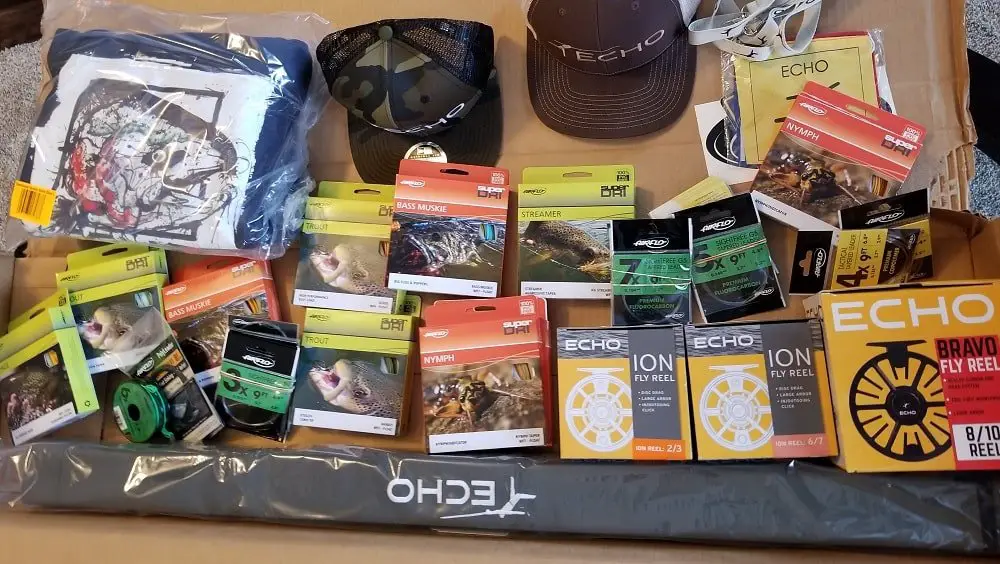
As a fly fishing guide, I get asked about the fly fishing gear that I and my guides use.
There is essential fly gear, which is the gear you absolutely need to fly fish and to catch fish, and there is non-essential gear, which is the gear you don’t really need; however, it can help you catch more fish and stay comfortable and safe.
Essential Fly Fishing Gear
- Fly Rod and Reel
- Fly line
- Fly leader
- Flies
Non-essential Gear Includes:
- Waders: Waders allow me to get into a better position to present my fly to the fish, as well as enable me to cross the river, stay warm, dry, and comfortable, and waders protect your legs.
- Fishing Jacket: Stay warm and dry with a good wading jacket with plenty of extra pockets for gear.
- Pack or Vests: Keep all your gear on your body where you need it.
- Wading Net: An important tool, especially when dealing with bigger fish.
- Tippet: An assortment of tippet sizes is very helpful for many reasons.
- Tools: Nippers, forceps, a thermometer, and fish handling glove.
- Polarized sunglasses: Protect your eyes from the sun and from stray hooks. I guarantee I would catch a lot less fish without them!
- Clothing: Proper clothes and a hat are important.
- Fly Boxes:
Everything from the rod and reel, the line, the leader, the tippet, and the flies. Gear for fly fishing also includes all the release gear and the gear that you wear.
We may make a small commission from some of the links on this website, which is at no cost to you. I appreciate your support. Learn More
Fly Rods
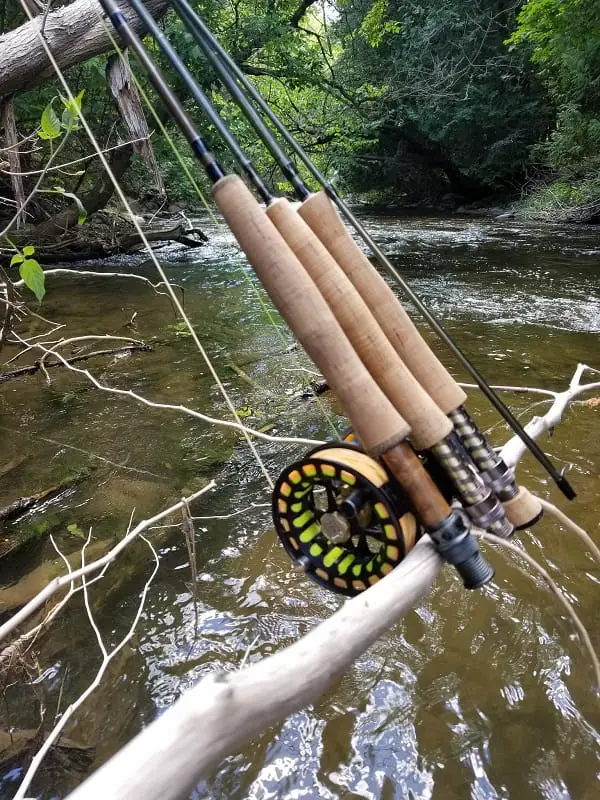
The fly rod is one of the most important pieces of gear that every fly angler needs.
With some fly rods under $60.00 and some over $1000.00, it’s hard to know which one you really need.
I have taught thousands of anglers how to fly fish using fly rods that sell for under $200.00, so if you are new to fly fishing, you will be happy to hear that a $200 rod is plenty.
When considering buying a fly rod, it’s vital to know that they come in different sizes. You need to have the right size for the type of fishing you do or the type of fish you want to catch.
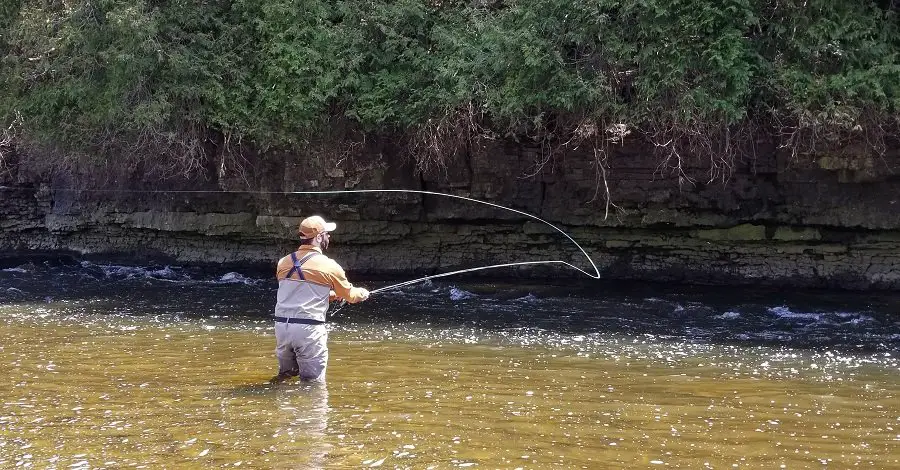
Fly Rod Weight | Type Of Fish | Fly Rod Length | Type Of River | Fly Fishing Method |
1 to 3 Weight | small trout, panfish | 8.5 to 9 foot rod - all pupose rod, -under 8 feet for small creeks. | small creaks to rivers up to 30 feet wide | Dry Fly, Nymphing, Wet Fly |
3 to 5 weight rod 4 weight - my favorite all purpose trout rod. | Best rod size range for most trout fishing | - 8.5 to 9 foot for general purpose. | small creaks or rivers up to 50 feet wide | Dry Fly, Nymphing, Wet Fly, Light Streamer Fishing. |
6 weight rod | larger trout, bass, pike, | 9 foot - all purpose rod 10 foot for nymphing | best on rivers 20 to 70 feet wide | Nymphing with big indicators, Wet Fly, Good streamer fishing rod |
7 to 8 weight | Steelhead, bass, pike, carp, great lakes salmon, larger species | 9 foot for general purpose and casting, 10 foot for steelhead and salmon nymphing. | best on rivers 30 to 90 feet wide | Nymphing with big indicators for steelhead and salmon, Good streamer fishing rod for large fish |
9 to 10 weight | Musky, Salmon, West coast steelhead | 9 foot for general purpose and casting, 10 foot for nymphing | best on big rivers of 30 to 120 feet wide | Nymphing with big indicators for steelhead and salmon, Good streamer fishing rod for large fish and far casts. |
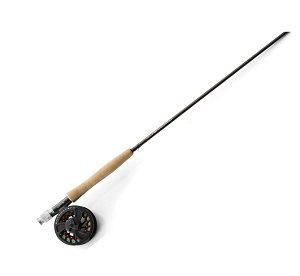
Best Fly Rod Combo Under $170.00
Orvis Encounter Combo – This is a great fly rod combo suitable for beginner and intermediate anglers.
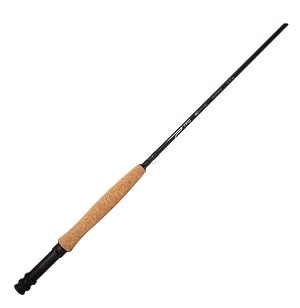
Best Rod Under $140.00
Redington Path II,
Another great rod by the well-known Redington Fly Company
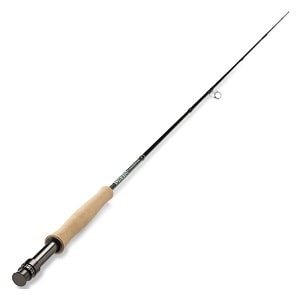
Best Rod Under $250.00
The Orvis Clear Water rod gets great reviews and is a great choice for a rod around $230.00
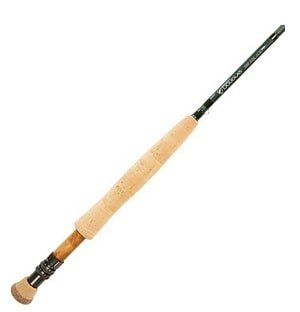
Best Mid-Priced Rod under $500.00
Douglas DXF Fly Rod – This rod has received great reviews and is a great choice for a rod around $400.00
If you are still not sure what the best rod is for what you want to do, I discuss fly rods in detail on my Best Fly Rods Page
Fly Reels
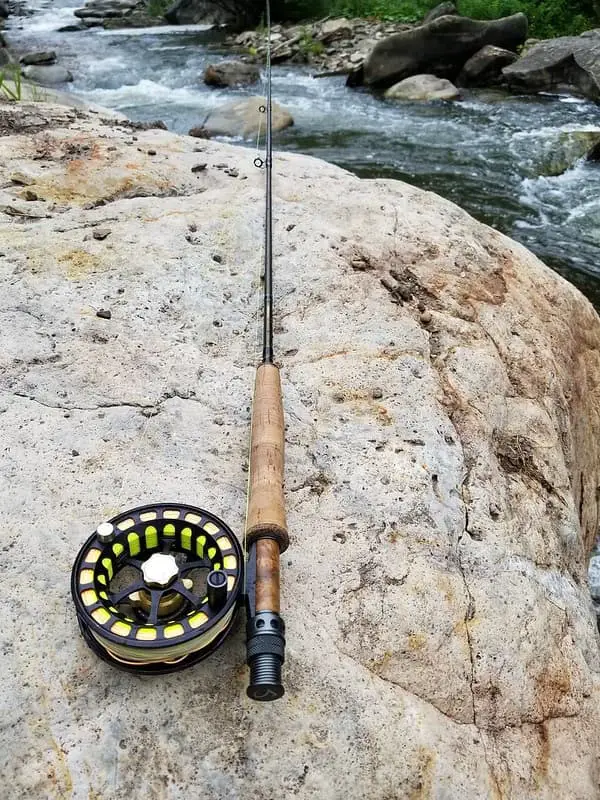
The key thing with any fly reel is that you want a good smooth drag and that the reel size matches the rod weight.
In other words, you want to make sure your fly rod and fly reel are balanced.
There are a lot of good reels over $100, but these are some tested and proven reels to consider.
- Redington Zero Fly Reel – Best Under $100.00 – Get It at FishUSA.com
- Waterworks Lamson Liquid Fly Reel – Best Reel Under $130.00 – Get It at FishUSA.com
- Orvis Battenkill Disc Drag Fly Reel – Best fly reel around $200.00 – Get It at FishUSA.com or
Keep in mind that you are going to need a different type of fly reel if you want to fly fish for big steelhead and salmon.
Fly Lines
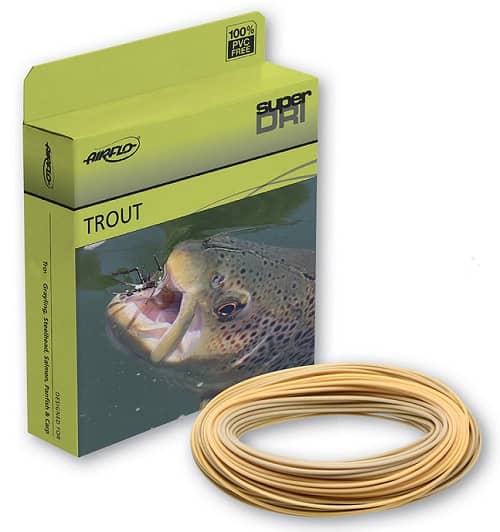
You can’t fly fishing without a fly line so I would consider a fly line to be an essential piece of your fly gear. A general-purpose weight forward floating fly line that matches the rod and reel is all you really need.
Weight forward lines are my preferred lines for teaching new anglers and for everyday use.
You will need to match the line to the rod and reel. A 5-weight fly line will go on a 5-weight fly reel, which goes on your 5-weight rod.
You can get the Airflo trout lines that I use at Trident Fly Fishing.
Other great fly lines that you can’t go wrong with are:
- Scientific Anglers Mastery Trout Fly Line – I found the best price at FishUSA.com or try Bass Pro Shops or Amazon.
- RIO Premier Gold Fly Line – Get it at FishUSA.com or Amazon.
Also, there are different fly lines that I use when fishing bigger water for steelhead and salmon, and you can check that out at The Best Fly Lines For Steelhead and Fly Line For Salmon.
Backing Line First
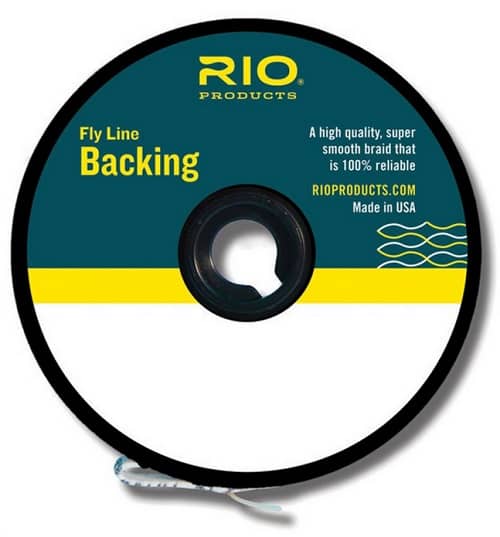
Fly Lines are only 90 to 110 feet long, and because of this, you need to add a line called a backing line to the reel, which then attaches to the fly line.
The backing also fills up the fly reel spool a bit so that the reel will be full, which is better when reeling in the line.
Always use a backing line, and a good choice for most fly reels would be a 20 pound, 50-yard spool of backing like the Rio Dacron Fly-Line Backing.

Fly Line Cleaners and Floatants
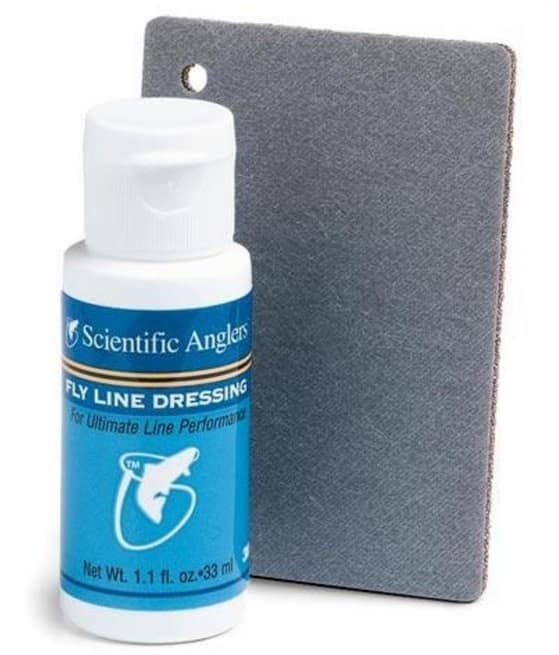
Although not an essential part of your gear, you will want a fly line cleaner and a floatant/dressing.
Your fly line can accumulate dirt and scum from the river over time which can start to sink your floating lines and make casting and mending more difficult. This means you will need a fly line cleaner.
I use the Scientific Anglers Fly Line Dressing and application pad, which cleans and dresses, and floats your line all-in-one shot.
Leaders For Fly Fishing
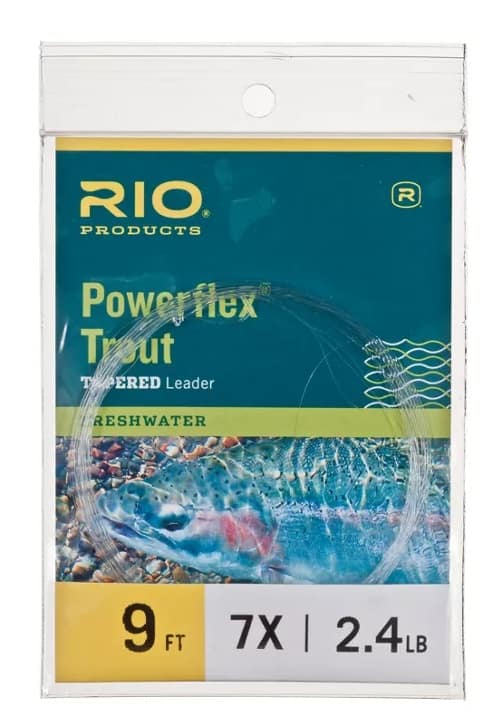
You can fish without a tapered leader for some methods of fly fishing, but a tapered leader will make things way easier for most casting and presentation. I suggest that you always have a few different sizes of leaders on you.
The tapered leader is thicker at the top and thinner at the bottom near the fly, and it acts as a clear extension of your fly line, which makes casting and mending far easier.
I use the 9-foot RIO Powerflex Trout Tapered Leaders. You can get them at FishUSA, and Amazon at these links.
Be sure to check out my page, Fly Fishing Leaders: A Complete Guide.
Tippets For Fly Fishing
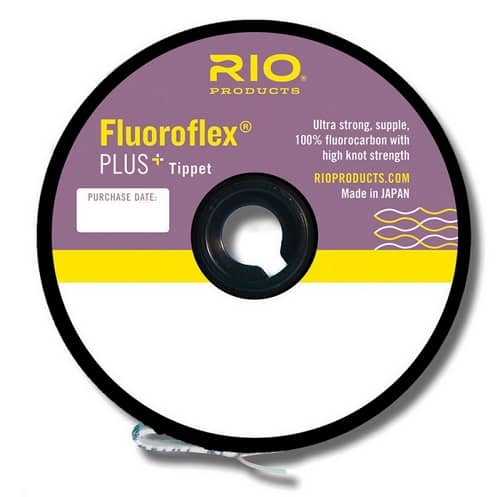
A tippet is a piece of line that is all the same diameter that attaches to the end of a fly leader. Most fly anglers have multiple spools of tippet
The reason we use a tippet is that it allows the angler to cut and retie many flies onto the line without cutting into the tapered leader.
If the end of your leader is 6 pounds, your tipper should be the same diameter or slightly less.
For dry fly fishing, I will use a tippet like the RIO Powerflex Tippet.
GUIDE TIP: Your leader and tippets are only as good as your knots. Are you using good knots? Check Out: 4 Best Knots Used By River Guides
Swivels Or Tippet Rings Versus Knots
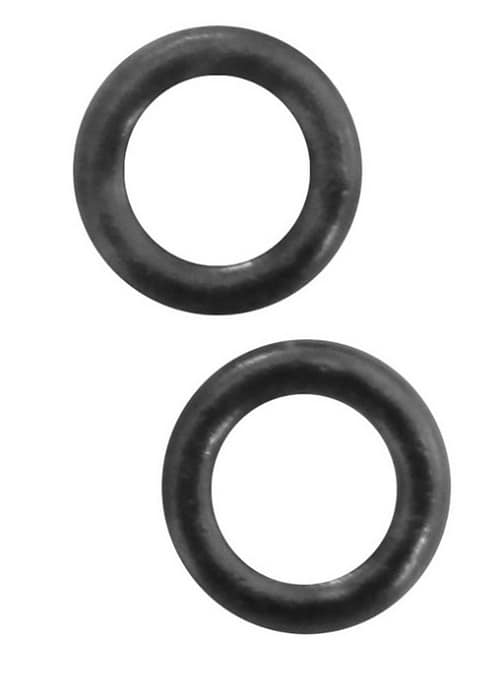
Swivels and Tippet rings are not essential but can come in handy, and they can preserve your tapered leader and help you make line-to-line connections easier.
Micro swivels like the Ravens XXSM Swivels can be used to connect the leader and tippet when nymphing or streamer fishing.
A tippet ring is a round enclosed ring that is much lighter than a swivel and can be used for all fly fishing, including dry fly fishing.
Using a tippet ring makes for easy removal and changing of an old tippet to a new tippet without cutting into your leader. This can make your leader last for many years.
The picture makes the tippet ring look huge, but they are only about 1/8″ across, which is very small and light.
Indicators And Sighters
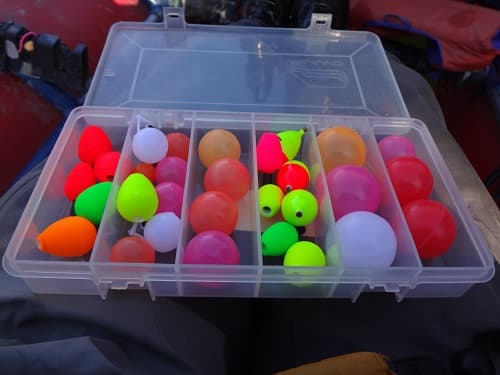
Indicators are like little mini-bobbers meant for fly fishing are a great addition to your setup if you nymph fish.
I like the Thill Ice ‘n Fly Special Indicator Or the Lightning Strike Indicator the best, and they are the ones I use to teach proper indicator nymph fishing. I like the 7/8″ for most trout fishing and the 1.5″ for steelhead fishing.
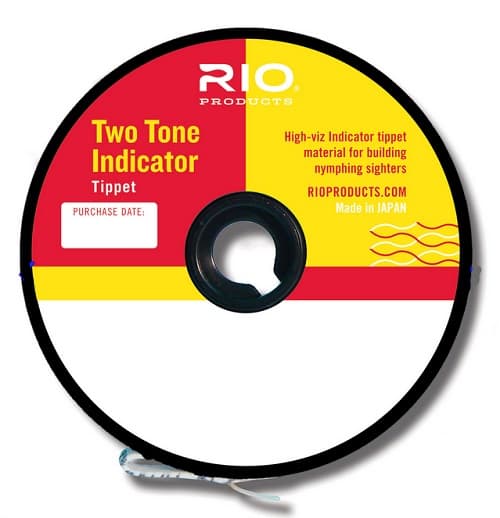
A sighter is a piece of line that is placed above your flies, and it helps you in detecting strikes like an indicator does, except that it’s not always floating on the water like an indicator.
The Sighter also helps you gauge and adjust your depth and your speed.
A sighter is often used by competition fly anglers using European or competition Nymphing methods.
My Favorite sighter is the RIO Two-Tone Indicator Tippet. Check the prices on Rio Indicator Tippets or buy them FishUSA.com, or at Amazon at these links.
For more information on using a sighter, check out my article Euro Nymphing.
Weights
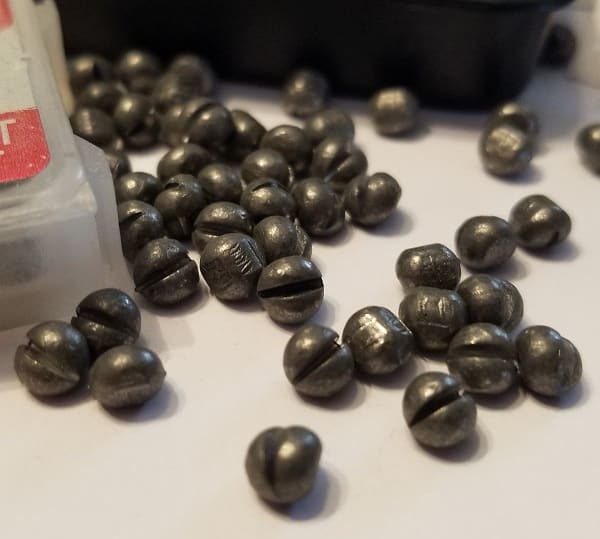
If you are nymphing, you will need to add some weights called split shots or tungsten putty to your gear.
I use BB or AB sized split shots placed strategically on the line to help get my flies down to the fish.
During the warmer months, I prefer to use tungsten putty weights instead.
Not all weights are good for fly fishing or river fishing which is why I recommend that you check out my page Fly Fishing With Weights for all the best weights and how to rig them properly for more trout and steelhead.
Flies For Fly Fishing
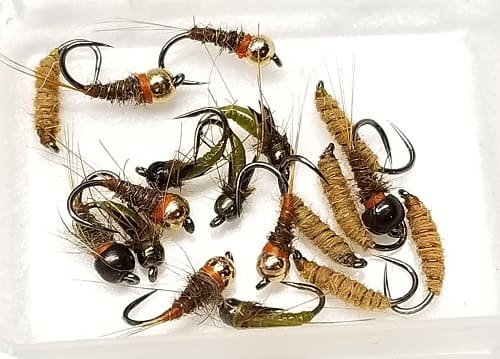
You are going to need good flies if you want to maximize your success on the rivers.
Flies for dry fly fishing, nymphing, streamer fishing, and wet fly fishing will be discussed on these pages:
Check out my page on the Best Flies For Steelhead and my page on 29 Best Trout Flies: Modern Flies Used By River Guides.
The Best Fly Boxes
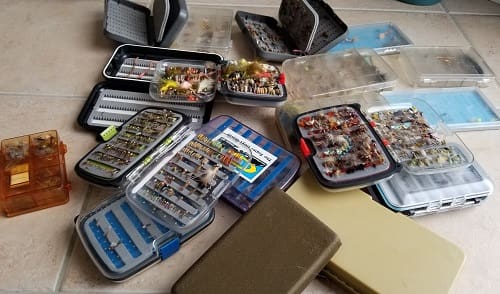
You will need a good fly box to put your flies into and there are all kinds to choose from.
A good fly box should be waterproof, have a solid latch, and separate slots for each fly, and should allow you to organize and view your flies easily.
There are two fly boxes that meet my criteria for a good box.
The Orvis Double-Sided Fly Box is a great waterproof box with a solid latch and the best types of fly slots that are good for both nymphs, dry flies, and small steamers.
The FishUSA Dual Sided Fly & Jig Box is just like the Orvis box but is not a see-through box. See-through boxes are great if you have multiple boxes and if you want to see what’s in them at a quick glance. But if you only have one box then a see-through is not a requirement.
The Cliff Bugger Box is great for all your streamer flies.
Check out my article, The 12 Best Fly Boxes For All Methods.
Fly Floatants Or Sinkets
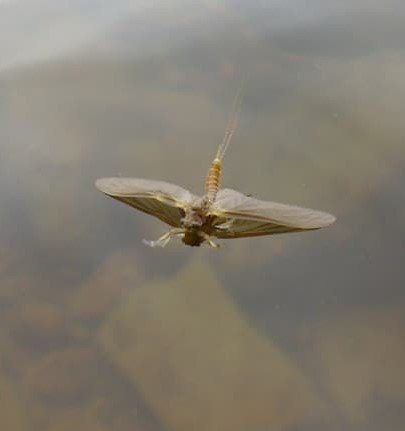
If you will be dry fly fishing, you will need a good dry fly floatant.
A floatant prevents the fly from absorbing water which will keep your fly floating longer and that means more fish and less time fussing with your dry fly.
I use a three step process for keeping my flies floating longer.
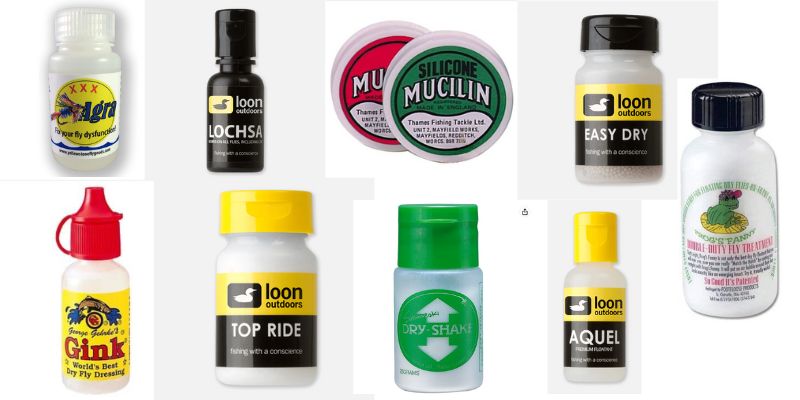
The Loon Outdoors Aquel Floatant Gel repels water and helps your fly float. This gel has been proven to be one of the best gels in tests, and I have used it for years so I know it works. You can get this at FishUSA.com – HERE or at Amazon – HERE
For a great powder floatant the Tiemco Shimazaki Dry-Shake Fly Fishing Floatant is a great choice. You can get this powder at Bass Pro Shops or at Amazon.
Another great one that I use and it gets great reviews is the Loon Top Ride.
You can see my eleven favorite fly treatments and fly floatants and how i use them together to get the best results on my page Best Fly Floatants: Tested
Sinkets or sinking gels are supposed to help your flies or your tippet sink.
A tippet that is below the surface is less visible to the fish which means fish are less likely to refuse your fly.
Hats
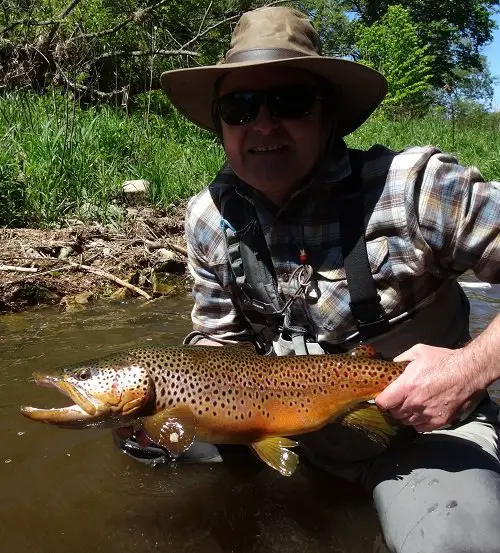
I wear a hat every time I go fishing and I consider them an important part of my gear for two good reasons.
Hats protect your head from the sun and rain but a good hat with a large brim all around also blocks out some of the light and the glare on the water which allows me to see deeper into the water.
Seeing into the water allows me to read the water better and find potential fish holding spots.
Baseball cap style hats are great but the primary disadvantage to them is that they still expose your ears and neck and therefore you risk sunburn there.
Cowboy style or Tilly hats, as seen in the picture above are a better choice for full head and neck protection. Check out this Airflo Tilly hat for anglers which you can get at Bass Pro Shops. Also, check out my article Best Fishing Hats.
Or, If you want to protect yourself from mosquitos, check out the SIMMS BugStopper Hat.
Glasses: A Must-Have Product
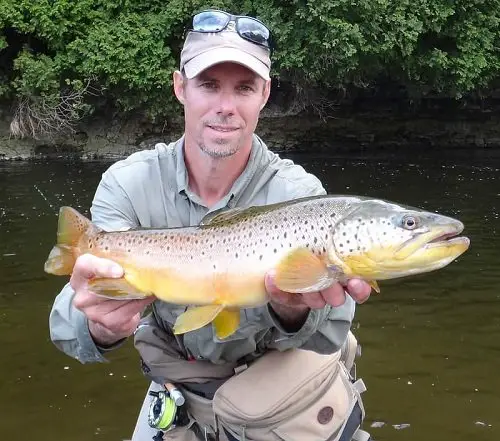
I could not do my job as a guide without the help of polarized fishing glasses and because of this I would consider fishing glasses an essential part of fly fishing.
Polarized fishing glasses help me see into the water better by cutting the surface glare.
Seeing into the water allows me to see deeper spots, bottom contours, and other hiding spots that fish might like to hold in.
Good fishing glasses will also enable me to see structure like logs and rocks that I or my clients might snag on. These same logs and rocks could also be key spots for holding fish so I want to be able to see them and glasses really help.
Polarized fishing glasses help me occasionally spot big fish, fish feeding, and fish that are moving or holding. Fishing glasses also help me see the bugs on and under the surface better as well as improve my ability to see my indicators and my flies on the surface.
I buy most of my fishing glasses from Bass Pro Shops.
Hooded Sun Shirt
For the same reason I wear a hat, to protect me from the sun I also wear a hooded fishing sun shirt almost all year long.
I like the Willit Men’s UPF 50+ Sun Protection Hoodie Shirt or the Roadbox Men’s UPF 50+ Sun Protection Long Sleeve Hoodie because it’s green and blends into the background along the river.
The Columbia Terminal Deflector Zero Long-Sleeve Hoodie is designed for summer fishing. You can also get it at Cabelas.
SIMMS also has a really cool Simms Men’s BugStopper Hoody that I like when the bugs are out in full force in the springtime.
Gaiters And Buffs
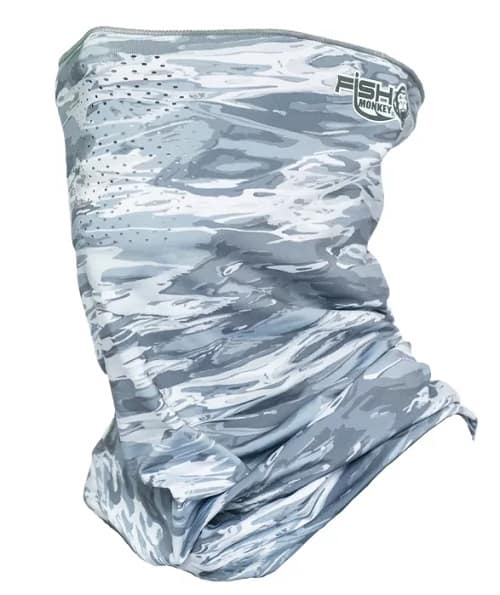
I call them buffs, but they are also known as face guards or gaiters and I wear them to help protect my face from sun exposure.
I like the Fish Monkey Flare Performance Face Guard because it has good features like the ventilated mouth area that prevents your breath from fogging up sunglasses.
Like all my river fishing gear I try to make sure my buffs are a color that blends into the background so I’m less likely to be spotted by the fish.
Wading Jacket
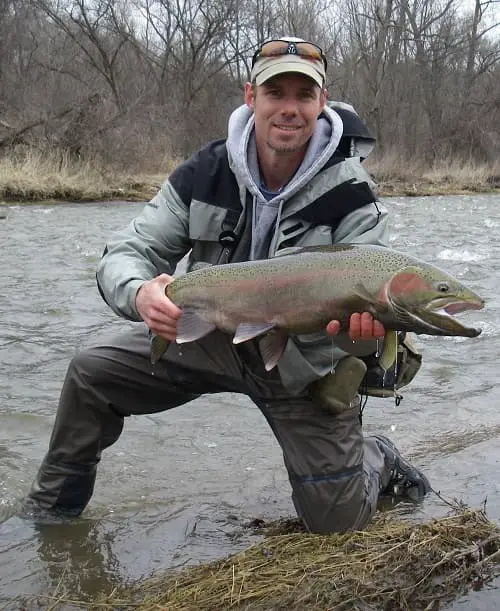
Good wading jackets will be waterproof, breathable, have a hood, and they will have plenty of pockets to store our year and fly boxes.
I’m currently using the Simms G3 Jacket and it’s the best wading jacket I have ever owned.
Click this link for all my tips on winter fishing and for layering under your wading jacket and how guides like me stay warm and dry.
Vests
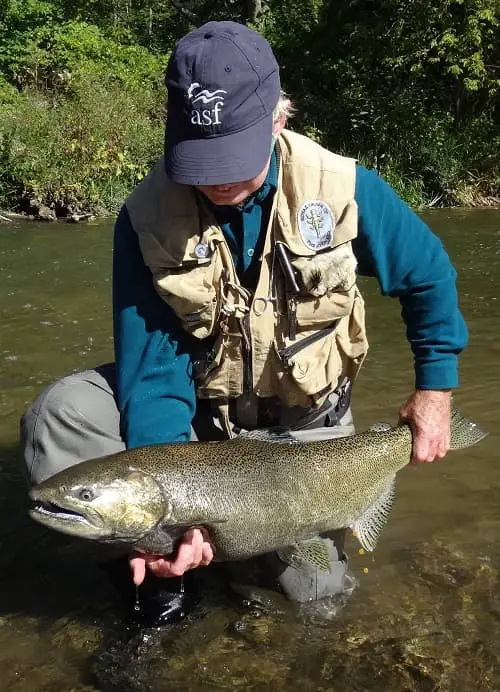
Fly anglers don’t carry around a tackle box because it’s better to have everything you need on your body.
With a good fly fishing vest you can be standing out in the middle of the river and all your gear is in your fishing vest and it’s all there when you need it when you need it.
Fishing vests like the Simms Men’s Freestone fishing vest are all you really need. Check out pricing on the Freestone Vest and other fly fishing vests.
Fishing Packs

Essential fly fishing equipment either includes a pack or a vest to carry your gear.
I find that a fishing vest full of stuff can be hard on your shoulders and back after a long day on the river.
This is why I now only use waist packs or sling packs. The sling pack still puts weight on your shoulder but the waist or the hip packs take all the weight off your shoulders and your back.
Some fishing packs like the Fishpond Blue River Chest/Lumbar Pack can be used as a waist pack or as a chest pack.
Some the best fishing packs either come from the FishPond brand or from the SIMMS brand.
Gloves For Warmth and Sun Protection
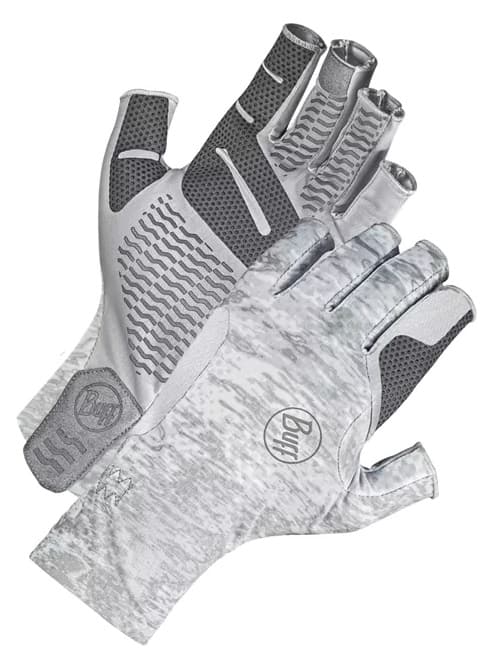
I use fishing gloves in the winter to keep my hands warm, but I also wear sun gloves to protect the tops of my hands.
If you want to try sun gloves, consider the Simms Sun Gloves which I have been wearing for about six years.
For winter gloves, see my best fishing gloves article.
Waders
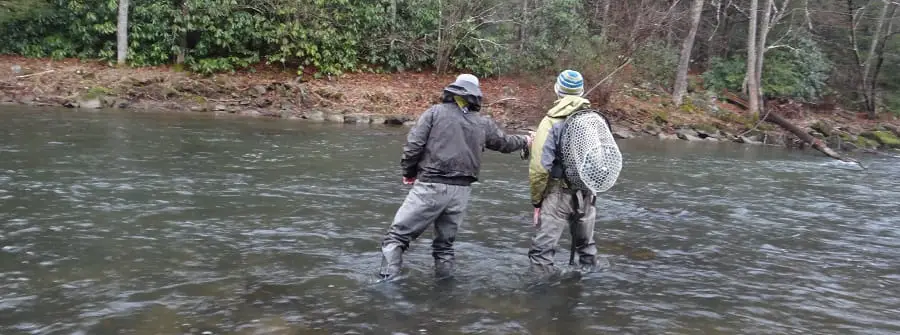
I practically live in waders and I consider waders an essential part of your fly fishing equipment.
I don’t just wear waders so I can walk in the water and not get wet. I also wear waders to protect me from poisonous plants, insects, ticks, and sharp objects.
I wear SIMMS G3 Guide Waders, but these are expensive and not for everyone. I have used many other bands, so even less expensive waders like these Frogg Toggs Hellbender PRO Stockingfoot Chest Waders for under $200.00.
Wading Boots 101
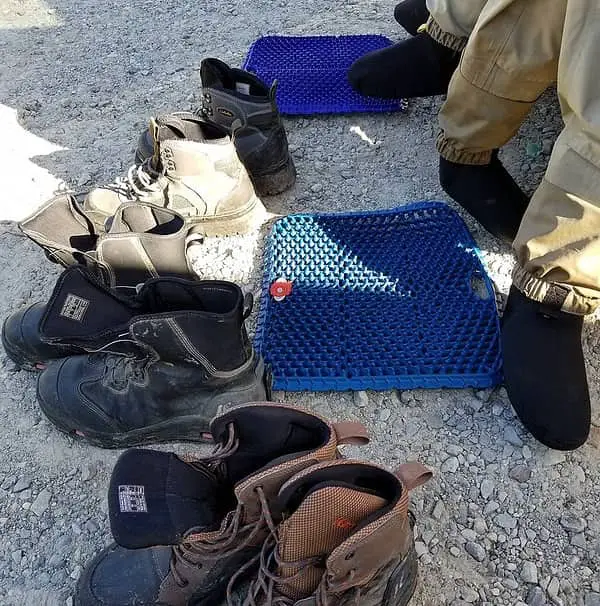
Wading boots are essential fly fishing equipment that you will need with stocking foot waders.
Good wading boots will act like hiking boots and protect your ankles and feet.
The boots that I wear now and have been wearing for about three years are the Korkers Devils Canyon Wading Boots, which are the black ones in the picture above.
I have all my clients that require boots in the Korkers Buckskin Wading Boots and they have been solid boots for under $100.00
Wading Staff
A wading staff will improve your balance and stability and might just save your butt from falling in.
The best wading staffs are over $100.00, but they are the best. For the best staff, look at the SIMMS wading staff or the Orvis Ripcord Wading Staff.
For a less expensive staff under $50.00, consider the Hairline Collapsible Aluminum Wading Staff.
Wading Nets
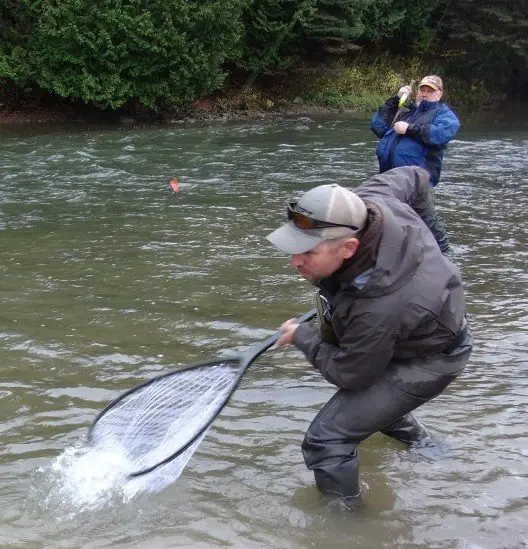
Wading nets are a must-have tool for river guides, but they are also very important for all river anglers and should be a part of your fly fishing setup.
I discuss the best wading nets and the ones that I use and recommend, and tips on how to attach them at 5 Best Trout Nets And Guides Advice On How To Attach Them.
Forceps
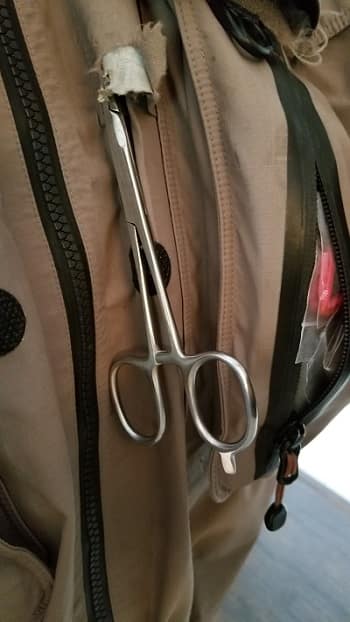
Forceps allow you to get deep hooks out of the fish’s throat and are a must-have fly fishing release gear tool.
There are times when the hook is so deep there is no way that you can do it with your fingers alone.
I like forceps with built-in scissors like the Orvis Scissor Forceps because I can and will use them to cut tippets and leaders and even trim off excess material from my flies.
Nippers
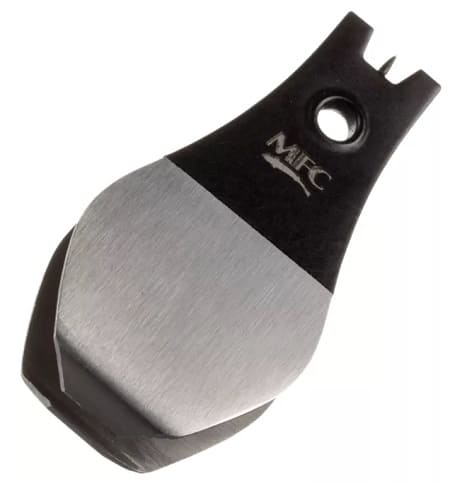
These are like nail clippers, but for your line and I USA nippers every day that i’m on the water.
Most of the nippers that I use are in the $15 to $30 range and they work great. Check out this $15 dollar Montana Fly Company River Steel Wide Body Tungsten Carbide Nippers at Bass Pro Shops.
Retractors and Zingers
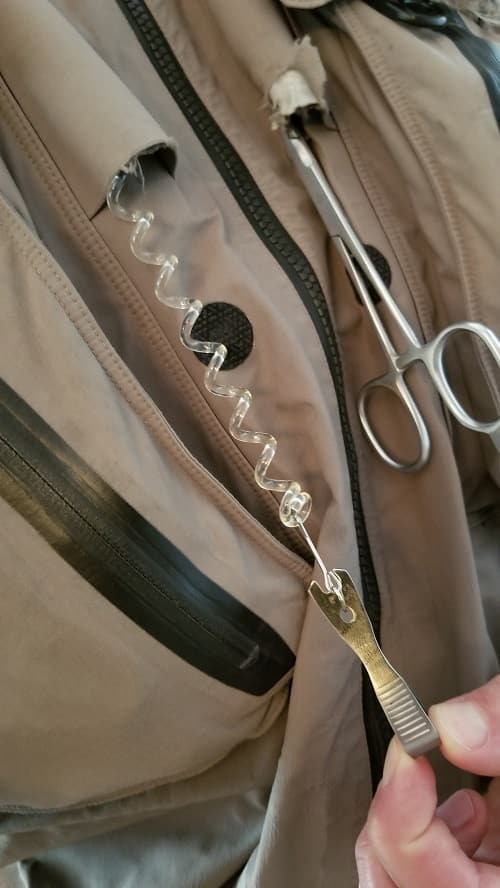
Retractors or zingers are little gadgets that I use for my forceps and for my nippers.
They are either a spring-type cord like the SIMMS Retractor which is the one you see in the picture or they are a retractable wire that goes in and out of small housing.
These are other fly tools that you should consider for your nippers and forceps.
Another good retractor is the Fishpond Cord Retractor which some anglers prefer.
I prefer the FishPond Swivel Cord Retractor version because they seem to hold up better than the wire ones.
Clip-on Magnifiers
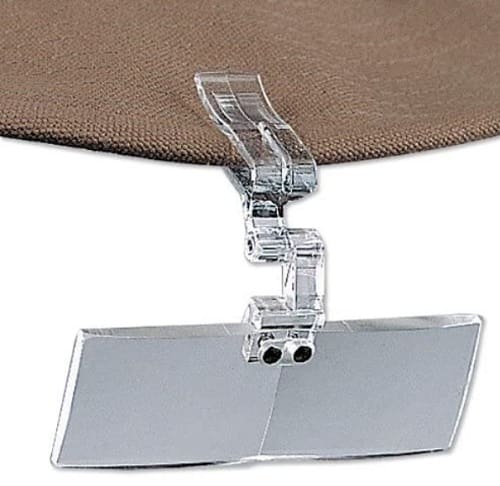
My clients ask me about the clip-on magnifying glasses on my hat all the time.
These are great if your vision prevents you from tying on small hooks with thin tippet.
The ones that I use and the ones all my clients ask me about are the Hat Flip Focals and are another great tool that can make your day easier.
Stream Thermometer
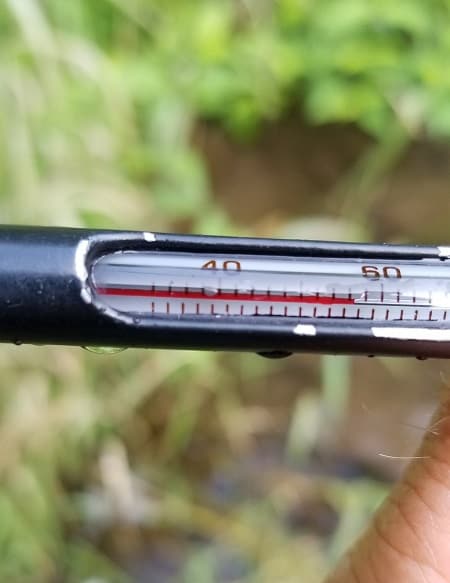
A stream thermometer is another useful tool to add.
I use a stream thermometer mostly during the summer months to make sure that I’m fishing water that is too warm.
There are all kinds of good stream thermometers and I have tested mine up against many of my client’s more expensive ones and mine is always bang-on perfect. The one in the picture is mine and you can get it at Bass Pro Shop HERE.
If you want a higher-end stream thermometer you should check out the Orvis Enclosed Stream Thermometer.
Tippet Holder
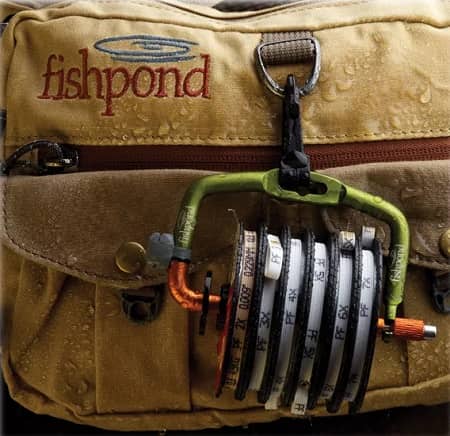
A tippet holder is a nice easy-access tool that attaches to your fishing vest or your fishing pack and is another tool that you should consider.
The tippet holder organizes your tippets better than just putting them all in your pocket and it makes grabbing your next piece of tippet easy.
The Rio Tippet Holder is a good choice.
This is the shortened article. In the full version I expand on many of the primary gear such as fly lines,. rods, reels, and more.. to see the full article check out this link. https://troutandsteelhead.net/recommended-fly-gear-expanded-version/
Tight Lines,
Graham

Don’t forget a trash bag to pick up garbage! Love the site been having success with the shot line method for trout. I actually use the trout hero bag for picking up trash it works well and the first one is free, which is nice way to encourage anglers to grab trash while they fish. https://pescadoronthefly.com/online-store/ols/products/trout-hero-bags-your-simple-reusable-bag-to-pack-out-trash-on-the-river-trout-unlimited-partnership